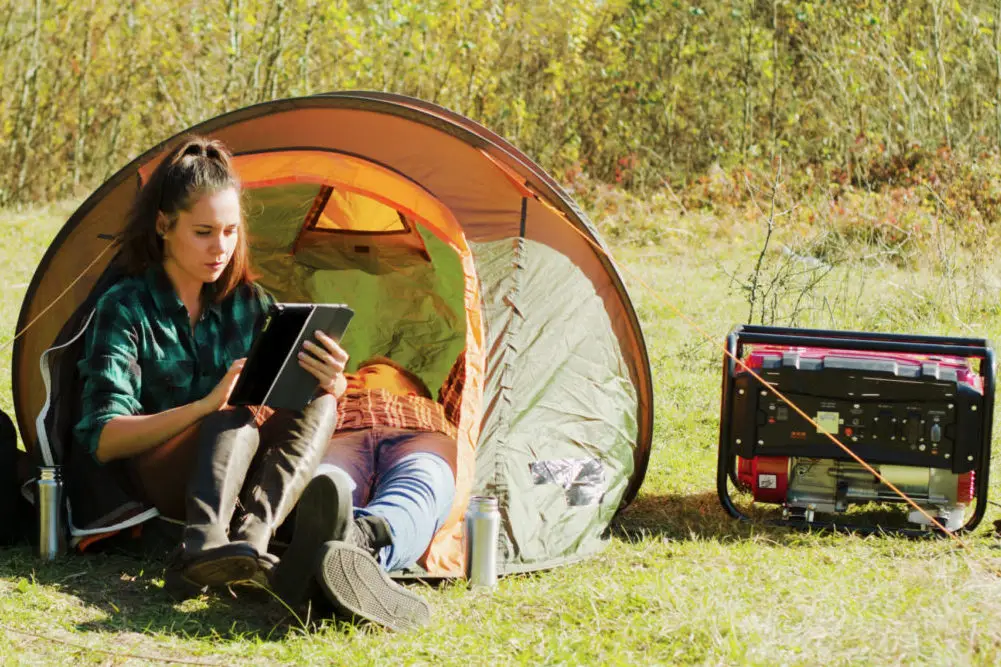Going camping can be a fantastic experience that is great for groups of friends, the whole family, or just a solo trip away from the hustle and bustle of modern life.
But sometimes we don’t want to escape back to caveman living and need access to electricity on a nature get-away.
You may feel like you’ll need access to an electrical grid, but that is not always the easiest feat when you are out in the middle of nowhere.
The thought of camping without electricity, especially if you are a parent with kids going with you, can be daunting and completely put you off. So how will you get access to electrical power to appease the young ones?
The easy answer, use a generator!

Table of Contents
Why use a Portable Generator?
Any generator is an engine that will generate electrical power, a portable generator is one that you can take around with you.
A device still capable of powering up large items, sometimes even items as needy as Air Conditioning units. But, they also have the plus side of being more lightweight and transport-friendly, rather than their larger, non-portable counterparts.
All you need is to power up the generator and plug in the cable so that you have access. It is important to remember to keep the generator at a distance, we recommend around 10-15ft distance between the generator and your camping accommodation.
What will you need?
Using a portable generator you need to be as safe as you possibly can be. The last thing you want is to be enjoying your camping trip and someone ends up seriously injured because the generator was not adequately grounded.
Grounding (sometimes called earthing) is the act of connecting an electric device to the ground so it is safe, it minimizes the chances of any electrical faults or electrocution. Some may not require grounding but if you have one that does, you must do so properly.
Stop! Before you set off, make sure you have what you need, tool-wise, for grounding your generator- here is a handy list of things that you need to check you have.
TOOLS
- Hammer: On the chance, things don’t go to plan it is always handy to have a hammer on duty. If need be you can use it to pound the copper rod into the ground.
- Copper Rod: This is essential for grounding your generator. It has to be a copper rod that is no shorter than four feet in length.
- Copper Wire: You need this to connect to the copper rod to generate a conductive electrical wire.
- Wire Strippers: An insulated grounding wire will often come as a standard addition with many portable generators. This means using wire strippers to remove insulation from both ends. It will make it easier to connect the grounding rod and copper wire, which will be attached to the generator.
- Pliers: What manual work doesn’t involve pliers? You will need these to wrap the copper wire around the grounding rod to create an effective long-term connection.
- Wrench: Once the grounding wire is stripped, you need to connect the generator. You will want to get your wrench to loosen the nut to complete this setup.
Grounding your Generator: How to?
Got the right tools? You’re ready to be on your way. Let’s look at how you will ground your generator for camping.
Start off burying the copper rod into the ground.
Get your handy hammer and bury the copper rod into the ground to around 8ft. The deeper it sinks the more grounded your generator will be.
If the ground is too hard, drizzle some water to soften the surface. If the surface is rocky you may have to get creative and try sinking it at different angles, just ensure that it does not pass a 90-degree angle!
Next, use the stripper wire on the copper wire.
Get your wire stripper out, and disconnect the copper wire from both ends.
Avoid over-stripping the wire and only focus directly on the parts that are needed for grounding.
Wrap one side of the wire onto the copper rod.
When you are sure that the rod is 8ft into the ground, you want to take one of the stripper copper wire ends and wrap it carefully around the rod with your pliers.
Attach to the generator.
Finally, you are ready to ground it. Attach the other end of the stripped copper wire directly to your generator.
Use your wrench to make the grounding bolt slightly loose and secure the wire tightly around this.
Once you have done so, tighten the bolt back up.
Staying Safe
When you do anything with a generator or anything else electrical it is important to be safe while you do so.
Here a few things you should keep in mind.
- Never place a generator indoors, outside at all times!
- Keep the generator away from openings; doors, windows, vents, etc.
- Do not overfill with diesel/ gas fuel
- Avoid spills at all costs.
- Do not place a generator near a household wiring system.
- Do not overload your generator with any tools, appliances, and so on. This is a backup system so should not be used as a full-time system when other options are available. Check how much power your appliances take and if your generator can deal with it.
- Use the correct cords.
Other Power Options
While generators are fantastic and a great choice of power, there are other options for camping that you can choose from, especially if you don’t have a portable generator and are not yet sure about investing.
SOLAR - Solar power is an option, it is possible to even buy solar-powered generators, these are much quieter and will work so long as the sun is about. They are also cheap to operate and make a great option for regular campers.
LITHIUM BATTERIES - Many people may carry rechargeable lithium batteries with them. They can be a great option but do need to be charged before the trip. They can power most small devices. We recommend these primarily for hikers.
- Are Merrell Shoes Good? – An Unbiased Review of Merrell Footwear - December 9, 2023
- Where Are Merrell Shoes Made? - December 9, 2023
- Camping in 40-degree Weather: Tips and Tricks - September 25, 2023


![How to Drive Stakes into Rocky Ground? [Need to Know] How to Drive Stakes into Rocky Ground? [Need to Know]](https://grandcircletrails.com/wp-content/uploads/2022/03/How-to-Drive-Stakes-into-Rocky-Ground-1-150x150.jpg)

![What Food Should I Bring for Camping? [Camping Food List] What Food Should I Bring for Camping? [Camping Food List]](https://grandcircletrails.com/wp-content/uploads/2022/01/camping-food-150x150.jpg)
![When Does Camping Season Start? [Best Time of Year to Go Camping] When Does Camping Season Start? [Best Time of Year to Go Camping]](https://grandcircletrails.com/wp-content/uploads/2022/01/When-Does-Camping-Season-Start-1-150x150.jpg)
![How to Protect Yourself While Camping? [TOP Camping Safety Tips] How to Protect Yourself While Camping? [TOP Camping Safety Tips]](https://grandcircletrails.com/wp-content/uploads/2022/07/How-to-Protect-Yourself-While-Camping-1-150x150.jpg)